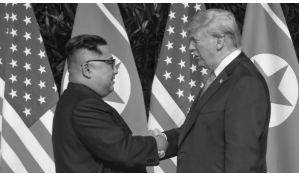Texto I
TRUMP-KIM SUMMIT: DONALD TRUMP VOWS TO 'END WAR GAMES' IN 'NEW HISTORY' WITH NORTH KOREA
By Ben Riley-Smith, US editor, in Singapore 13 JUNE 2018 • 8:10AM – The Telegraph
Photo: https://goo.gl/wcMQ1V
Donald Trump unexpectedly suspended "war games" on the Korean peninsula yesterday as he convinced Kim Jong-un to back "complete denuclearisation" in a written agreement. The US has been carrying out joint military exercises for years in the region as a signal of its military alliance with Seoul (South Korea), and as a show of strength against North Korean aggression.
The US president said in a press conference after the Singapore summit: "It is a very great day, it is a very great moment, in the history of the world." He predicted Kim would start denuclearise "very quickly" and revealed that the North Korean leader had already agreed to destroy a missile engine testing site.
The climax of Mr Trump‘s meeting with Kim — the first between a sitting North Korean and American leader — was the signing of a joint agreement. The 400-word statement followed more than four hours of talks, first between the leaders one-on-one and then with a wider group of advisers.
It read: "President Trump and Chairman Kim Jong-un conducted a comprehensive, in-depth, and sincere exchange of opinions on the issues related to the establishment of new United States - North Korea relations and the building of a lasting and robust peace regime on the Korean Peninsula.
The statement went on to list four specific pledges that both Mr Trump and Kim agreed to stand by: The first was that both countries would establish "new relations" in the pursuit of "peace and prosperity" — an attempt to draw a line under the insults and threats of last year. The second said that America and North Korea would "join their efforts to build a lasting and stable peace regime on the Korean Peninsula". The third said that Kim‘s regime ―commits to work toward complete denuclearisation of the Korean Peninsula‖ — a key demand from the Americans. And the fourth promised that the remains of fallen US soldiers who died fighting in the Korean War would be repatriated to the United States.
Mr Trump said he "absolutely" would invite Kim to the White House and expressed enthusiasm for visiting North Korea, but said no dates had been set. Mr Trump also praised the leaders of Japan, South Korea and China as well as Kim himself for the progress made on the issue of denuclearisation.
Source: < https://goo.gl/dEim38> Date of retrieval: June 13th, 2018.
Na frase do texto I, "a signal of its military ALLIANCE with Seoul", a palavra ALLIANCE poderia ser substituída, sem alterar seu sentido, por:






